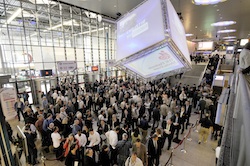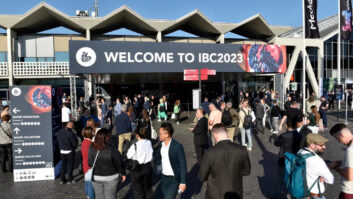
Featuring big visitor numbers and much confidence, IBC2010 put a smile back on the face of an industry emerging, still cautiously, from the economic woes of 2009. Of course 3D loomed largest, but what was it that was really paying the bills? Mark Hill reports.
Broadcast TV – it just works! For many at the show, the answer to what was paying the bills was unquestionably good old regular, linear, 2D, mostly SD, broadcast television. Perhaps surprising after years of forecasts that such is in terminal decline. A case of overestimation of the impact and underestimation of the time it will, or should that be ‘may’, take for this to happen.
When it comes to the small matter of delivering a quality service to the consumer, and getting a return for doing so, regular TV is proving a massively hard act to follow. This applies from a variety of perspectives — technical, financial and, for the humble consumer, that of the ‘viewer experience’.
To some who are now becoming part of our industry, the amount of effort and expense expended in making broadcast TV work over the years might appear disproportionate to the seemingly straightforward nature of the end result. Try to produce a viable alternative, however, and the realisation dawns that the competition is a slick machine.
There’s no doubt that file-based, IT-enabled, TV down the same wires as you receive e-mail is attractive, but ready for ‘primetime’? The push to sell (and keep selling) screens – 2D, 3D, whatever – means the TV is being dragged kicking and screaming from a switch-on, good to go, household appliance to become a sort of giant wall-mounted laptop, with all of the potential benefits and real-world frustrations that that brings.
For the time being at least, the set top box (STB) exists as an attempt to preserve some sanity. Some may question its long-term future; however in the short- to medium-term its existence seems assured as a device that allows consumer and broadcaster interests to meet and co-exist. Sure, the STB is a direct channel into your bank account on the part of a platform operator, but it’s not a one-way street. The services it provides in return for your monthly consideration are generally slickly packaged and presented, and ‘work’.
If the modern TV set — with all its ‘widgety’ promise, USB and network connectivity and increasingly unfit for purpose remote control — has become bogged down in the mire of details associated with ‘IT does TV, on the TV’, ‘IT does TV, on the PC’ has fared much better. The consumer expects the experience to be ‘different’ and accompanied by normal IT issues. They are not disappointed … hang on, just buffering the next bit …
As an industry, exciting though the multitude of technology-driven possibilities are, we must be careful, realistic and honest when we offer a service to the consumer. It’s crunch time for the TV: either make it a good computer, with a decent human interface, or else just make it a high-quality, simple screen and invest the interface and intelligence in something else.
Non-standards wars
The proliferation, interpretation and (patchwork) adoption of non-proprietary industry standards relating to content formats continues to be an issue for those trying to systemise. It’s odd but where standards have absolutely had to succeed – CD; MPEG; DVD; DVB etc – they generally have. With others – VHS; Blu-ray etc – the market decided and success followed. For those standards aimed at making life on the ‘sending end’ easier, however, success remains a work in progress.
The key difference in the above examples seems to be the size of the target audience. On its own, the audience at the sending end is seemingly just too small to encourage universal coalescence and convergence. Just look at the proportion of sending end sellers and buyers that can be contained within the walls of IBC2010.
The workaround that has so far been adapted to this situation is to make those standards aimed at appealing to industry professionals so accommodating that they (and their parts) can be adopted/implemented in a pick-and-mix manner. This feels like part of the problem and not part of the solution.
Standards making is a time-consuming and costly business, so it’s hardly surprising then that manufacturers, many of whom have a foot in both consumer and professional camps, get fatigued and just retire to do their own thing. Why should a manufacturer of desktop editing software pay much attention to the needs of the 50,000 when the big prize is meeting the needs of the 50m?
Much effort is now being expended in devising ways to make manufacturer proprietary standards interoperate. Is this the future? Don’t you just hate it when a plan doesn’t come together?
Fall of the ‘vanilla’ server
There’s no doubt that the video server has done great things for the TV production and broadcasting business. While the consumer has reaped some (indirect) benefits, most of the up-side has been within the production and distribution parts of the content value chain. Once again, however, IBC2010 highlighted that a shift in technology is taking place.
For broadcast playout applications, a ‘plain’ video server typically needs to be followed by a string of other devices comprising the channel chain: router – vision switcher – video effects unit – audio voice over server – graphics replay engine – subtitle insertion processor etc. This external ‘systemisation’ complicates the task of delivering channels and, of course, comes at a price. If some, or all, of these supplementary devices are usually always required, why not package them together somehow? Welcome to the ‘integrated device’.
While there are differences in the balance of standard and custom hardware and software that such integrated devices employ, the net result is developing nicely and will come to represent an overall more flexible and cost-effective way of powering channel playout centres than the obligatory video server plus systemisation route to which we have grown. Companies such as OmniBus (Miranda) and PubliTronic are counting on it, while others, such as Pebble Beach, are now firmly giving customers the option.
Hardware codecs in video servers are also set to become a relic of the past, being overtaken by their software-only equivalents, made possible by the ever improving price/performance ratio of computing power and the availability of knowledge as to how to implement them. Going hand in hand with the ‘shift to soft’ above, one further welcome feature of modern video servers is their increasing ability to mix and match content encoded to different standards (including different aspect ratios) on the playout timeline.
Welcome sighs of relief can be heard from all operators who might otherwise need to engage with the nightmare that is maintenance of multiple inventories of content in SD, HD, or whatever — and/or those that have given up on standards.
To agility, and beyond!
IBC2010 delivered evidence that manufacturers of video processing equipment (‘glue’ et al) had been busy combing through their product ranges and moving to increasing use of common hardware for SD; ‘1.5G’; and (in some cases) even ‘3G’ HD video standards. Accompanying this common hardware for many is now the use of customer purchased (software) licence keys to determine final, ‘in-service’ capability. This approach is great news for customers trying to make the call between SD and HD standards.
MAM
On the Media Asset Management (MAM) scene, results of mergers and acquisitions were in evidence: suppliers of global networking solutions for media, GlobeCast and Tata, were both extolling the virtues of their accompanying MAM solutions, resulting from their acquisitions of Netia and BT Mosaic respectively.
Media Archive, the main MAM product of Blue Order AG, and the one at the heart of BT Mosaic now exists as part of Interplay, following the acquisition of Blue Order by Avid earlier in the year. Artesia, another MAM name stretching back many years, had completed its conversion to become Media Management 7.0 (Open Text Digital Media Group).
OmniBus had decided that its MAM offering should form an integral part of its ‘iTX Enterprise Suite’. This was followed swiftly by the announcement at the show that OmniBus had itself been bought by Miranda, bringing MAM and IT-based playout home to Canada.
Price points for MAM generally appeared to be continuing to soften with functionality having now reached the point where consolidation was being prioritised over new features. Business Process Management (BPM)/Workflow remains as firmly ‘in’ and, responding to repeated input from customers, tools allowing users to graphically configure their own workflows were developing to the point of being usable by other than the developers of the software code. The lesser known names of Spanish company Tedial and Italian company Mantrics have both been busy in this regard.
The 3D affair
The practicality and promise of 3DTV appeared to be summed up at the show by, respectively, camera rigs reminiscent of those fresh from the lab for ‘HD’ 2D in the 1930’s and Sony’s mock-up of a potential 3D camcorder.
Surely though the most impressive part of the whole 3D affair to date has been the speed of response by the industry to the challenge of assembling a value chain that stands any chance of making it into productive, commercial use. Whether there really is that much promise in 3DTV to justify the massive amount of time and attention that’s been spent, only time and perhaps Sky subscriber numbers will tell.
In mainstream TV, it all still looks very ‘niche’. Warnings of the, ‘don’t drink alcohol or operate machinery type’ before or after watching 3DTV surely don’t sit comfortably with a prospective audience of sport fans trying to watch a football game in a pub.
If only the effort put into getting 3D up and running had been applied to ridding our world of incompatible, interlaced, slow frame rate TV instead. Ah well — one can dream …
Sunday evening’s showing of Toy Story 3 in 3D of course provided a salutary lesson for the many that attended. Of all those that went in to look at the intricacies of the 3D, how many came out even caring that the feature was made/shown in 3D? Quite – good storytelling and good content beats neat technology every time. Onwards and upwards folks!






